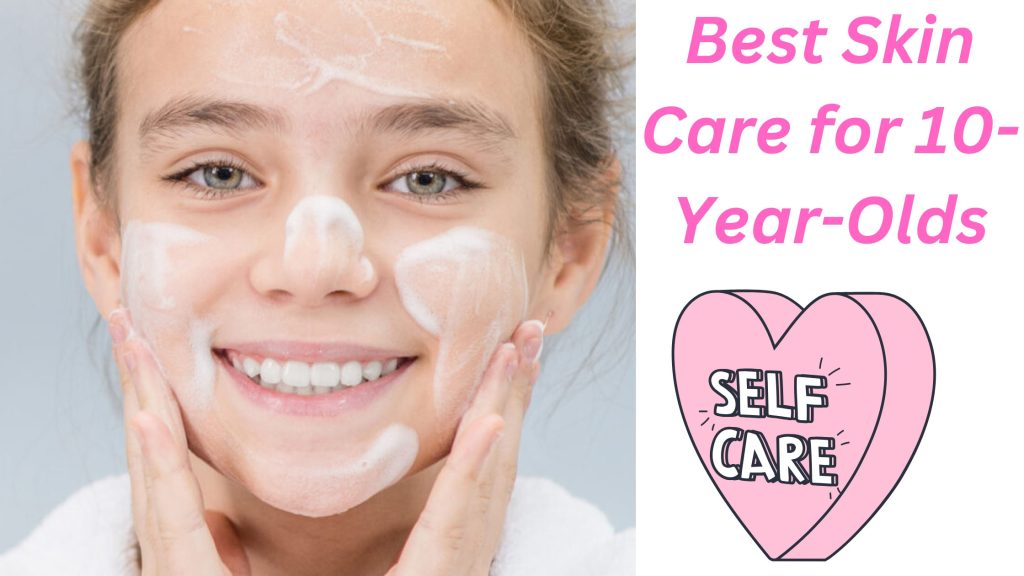“Best skin care for 10-year-olds” is a common question for every parent. Children’s skin is still soft, delicate, and developing at this age. A simple skincare routine can help them learn healthy habits and meet their unique skin needs.
Best Skin Care for 10-Year-Olds: A Gentle and Effective Guide
Taking care of the skin is important at any age. For 10-year-olds, the focus should be on gentle, natural, and simple practices. At this age, children are moving from toddlerhood to pre-adolescence. Their skin is still soft, delicate, and developing. A simple skincare routine can help them learn healthy habits and meet their unique skin needs.
This guide explores the best skincare practices for 10-year-olds. We’ll cover cleansing, moisturizing, sun protection, and other tips for healthy skin. We aim to empower both children and their caregivers with a soft and reassuring tone.
Understanding the Skin of a 10-Year-Old
At age 10, most children’s skin is healthy and resilient. It is usually free from major issues like acne or wrinkles. However, It is more sensitive than skin of an adult. It can be prone to dryness or irritation. Hormonal changes are just starting, so their skin needs minimal but consistent care to stay balanced and protected.
Skincare should focus on three main goals. First, it should maintain the skin’s natural barrier. Second, it should provide moisture. Lastly, it should protect the skin from outside stressors, such as pollution and the sun. Simplicity is key, as harsh products or complicated routines can cause more harm than good.
1. Gentle Cleansing: The Foundation of Healthy Skin
Any skincare regimen is built on cleansing. Ten-year-olds want to get rid of dirt, perspiration, and filth without depleting their skin of its natural oils.
Why It’s Important
Children are active and often play outside, so their skin can collect dust and impurities. A gentle cleanse keeps their skin fresh and clear while preventing clogged pores.
What to Use
- Mild, Fragrance-Free Cleansers: Choose products labeled “sensitive skin” or “gentle.” For younger skin, ingredients like chamomile and aloe vera are calming.
- Avoid Harsh Soaps: Bar soaps or adult cleansers with strong fragrances can dry out and irritate their skin.
How to Cleanse
- Twice a day, morning and before bed, wash your face.
- Use lukewarm water and a soft washcloth or clean hands.
- Rinse completely after gently massaging the cleanser in circular motions over the skin.
2. Moisturizing: Keeping Skin Soft and Hydrated
Even young skin can become dry, especially in colder months. A good moisturizer helps protect the skin and locks in moisture.
Why It’s Important
Moisturizers create a protective layer that prevents water loss, keeping the skin soft. Hydrated skin is less likely to become irritated.
What to Use
- Lightweight, Non-Greasy Formulas: Choose fragrance-free products with ingredients like glycerin or hyaluronic acid.
- Specialized Products for Dry Skin: If your youngster has dry skin, go for creams rather than lotions for additional moisture.
How to Moisturize
- Apply moisturizer while the skin is still slightly wet after washing.
- Rub it lightly into the skin using a pea-sized quantity.
- Focus on areas prone to dryness, like around the nose or cheeks.
3. Sun Protection: A Lifelong Habit
Among the most crucial skincare lessons is teaching sun safety. Sun damage builds up over time and can lead to skin issues later in life.
Why It’s Important
A 10-year-old’s skin is more vulnerable to UV damage. Regular sunscreen use helps prevent sunburn and long-term harm.
What to Use
- Mineral-Based Sunscreens: Look for gentle but effective products with zinc oxide or titanium dioxide.
- SPF 30 or Higher: It is essential to have broad-spectrum protection against UVA and UVB rays.
- Water-Resistant Formulas: Perfect for energetic children who like swimming or outdoor activities.
How to Apply
- Two hours after swimming or exercising, reapply sunscreen.
- Use enough to cover all exposed skin, including the face, neck, ears, and hands.
4. Hydration and Nutrition: Skin Health From Within
Good skincare goes beyond mere application on the skin. It also depends on your drink and nutrition. Good skin depends mostly on a balanced diet and adequate water.
Why It’s Important
Staying hydrated helps keep the skin elastic and glowing. A balanced diet provides the nutrients needed for skin repair.
Tips for Hydration
- Encourage drinking water throughout the day. Aim for about 6-8 glasses, depending on activity levels.
- Include hydrating foods like watermelon, cucumbers, and oranges.
Nutritional Tips
- Fruits and Vegetables: Vitamins A, C, and E abound in these and support skin health.v
- Healthy Fats: Foods like avocados, nuts, and seeds help maintain the skin’s natural barrier.
- Proteins: Important for skin repair and renewal.
5. Building Simple Habits for a Lifetime
A child’s skincare habits at 10 can shape their future. Keeping things simple and consistent makes skincare feel enjoyable, not like a chore.
Daily Habits to Encourage
- Wash hands often to avoid transferring dirt and bacteria to the face.
- Avoid picking or scratching at the skin to prevent irritation and scarring.
- Use clean towels and pillowcases to reduce exposure to germs.
6. Addressing Specific Skin Concerns
Some 10-year-olds may have mild skin issues like dryness or occasional breakouts. These can usually be managed with gentle care and a few targeted products.
Dry Skin
- Use a richer moisturizer and apply it twice a day.
- Consider adding a humidifier to the child’s room, especially in winter.
Eczema
- Find moisturizers that say they are “eczema-friendly” and have components like colloidal oatmeal..
- Consult a pediatric dermatologist for persistent or severe cases.
Breakouts
- If blemishes occur, avoid harsh acne treatments.
- Use a mild, non-comedogenic cleanser and keep the skin moisturized.
7. Avoiding Common Pitfalls
To make the skincare routine effective and enjoyable, avoid these mistakes:
- Overdoing It: More products do not mean better skin. Stick to the basics.
- Using Adult Products: These can have ingredients that are too strong for young skin.
- Skipping Sunscreen: Consistent sun protection is essential.
Encouraging Confidence and Self-Care
Skincare is not just about health; it also builds confidence and self-esteem. Encouraging children to care for their skin helps them take pride in their appearance.
Make skincare a fun activity by involving them in choosing products or teaching them how to apply them. Keep the tone light and positive, focusing on keeping their skin healthy and comfortable.
Conclusion
The best skincare routine for a 10-year-old is simple, gentle, and consistent. To keep their skin healthy, focus on these four things:
- Cleansing
- Moisturizing
- Sun protection
- Healthy habits
This will also help teach them about self-care.
Remember, Each child’s skin is different. Be mindful of how their skin reacts, as a solution that benefits one person may not be effective for another. Should certain issues surface, a pediatric dermatologist may provide specific recommendations.
Your 10-year-old can have healthy, glowing skin. These gentle and effective practices will help. They will also boost their confidence now and in the future.


